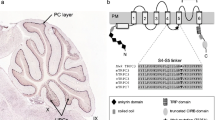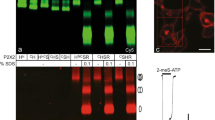Abstract
Even though the genomes of several major species have been sequenced, many orphan receptors with unknown ligands and mechanisms of action remain in the CNS. The δ2 glutamate receptor (GluRδ2) is one of such receptors expressed predominantly in the cerebellar Purkinje cells. On the basis of amino acid similarity, it belongs to ionotropic glutamate receptor (iGluR) family, which mediates fast excitatory neurotransmission in the mammalian CNS. Although its null-mutant mice show prominent motor discoordination, the mechanisms by which GluRδ2 participates in the cerebellar functions have been unclear. To gain insight into GluRδ2’s mechanisms, we recently generated mice that express either a wild-type or a mutant GluRδ2 transgene, in which the conserved arginine in GluRδ2’s N-terminal putative ligand-binding motif was disrupted. By breeding these transgenic mice onto a GluRδ2−/− background, we obtained two transgenic ‘rescue’ lines. Surprisingly, the mutant GluRδ2 transgene was as effective as the wild-type GluRδ2 in rescuing the GluRδ2-null mice. As the disrupted arginine residue is highly conserved from ancestral bacterial periplasmic amino acid-binding proteins to mammalian iGluRs, we propose that GluRδ2 may not require glutamate-like amino acids and may function in an unconventional manner. This ‘transgenic rescue’ approach to investigating orphan receptors is a relatively easy but powerful method when a knockout mouse with a distinct phenotype is already available. The advantages and limitations of this approach, together with certain cautions in interpreting the resulting data, are discussed in this review.
Similar content being viewed by others
References
K Araki H Meguro E Kushiya C Takayama Y Inoue M Mishina (1993) ArticleTitleSelective expression of the glutamate receptor channel delta 2 subunit in cerebellar Purkinje cells Biochem Biophys Res Commun 197 1267–1276 Occurrence Handle10.1006/bbrc.1993.2614 Occurrence Handle1:CAS:528:DyaK2cXhvVelsrs%3D Occurrence Handle7506541
H Hirai T Launey S Mikawa T Torashima D Yanagihara T Kasaura et al. (2003) ArticleTitleNew role of delta2-glutamate receptors in AMPA receptor trafficking and cerebellar function Nature Neurosci 6 869–876 Occurrence Handle10.1038/nn1086 Occurrence Handle1:CAS:528:DC%2BD3sXlslOju78%3D Occurrence Handle12833050
H Hirai T Miyazaki W Kakegawa S Matsuda M Mishina M Watanabe et al. (2005) ArticleTitleRescue of abnormal phenotypes of the delta2 glutamate receptor-null mice by mutant delta2 transgenes EMBO Rep 6 90–95 Occurrence Handle10.1038/sj.embor.7400312 Occurrence Handle1:CAS:528:DC%2BD2MXitVertg%3D%3D Occurrence Handle15592450
T Ichise M Kano K Hashimoto D Yanagihara K Nakao R Shigemoto et al. (2000) ArticleTitlemGluR1 in cerebellar Purkinje cells essential for long-term depression, synapse elimination, and motor coordination Science 288 1832–1835 Occurrence Handle1:CAS:528:DC%2BD3cXjvFCitb0%3D Occurrence Handle10846166
M Ito (1989) ArticleTitleLong-term depression Annu Rev Neurosci 12 85–102 Occurrence Handle1:CAS:528:DyaL1MXhvVKjsbY%3D Occurrence Handle2648961
M Kano M Kato (1987) ArticleTitleQuisqualate receptors are specifically involved in cerebellar synaptic plasticity Nature 325 276–279 Occurrence Handle1:CAS:528:DyaL2sXps1Omtw%3D%3D Occurrence Handle2880297
N Kashiwabuchi K Ikeda K Araki T Hirano K Shibuki C Takayama et al. (1995) ArticleTitleImpairment of motor coordination, Purkinje cell synapse formation, and cerebellar long-term depression in GluR delta 2 mutant mice Cell 81 245–252 Occurrence Handle1:CAS:528:DyaK2MXlt1Kisrg%3D Occurrence Handle7736576
H Lomeli R Sprengel DJ Laurie G Kohr A Herb PH Seeburg et al. (1993) ArticleTitleThe rat delta-1 and delta-2 subunits extend the excitatory amino acid receptor family FEBS Lett 315 318–322 Occurrence Handle1:CAS:528:DyaK3sXktVWis7s%3D Occurrence Handle8422924
S Matsuda T Launey S Mikawa H Hirai (2000) ArticleTitleDisruption of AMPA receptor GluR2 clusters following long-term depression induction in cerebellar Purkinje neurons EMBO J 19 2765–2774 Occurrence Handle1:CAS:528:DC%2BD3cXmtFCru70%3D Occurrence Handle10856222
E Mayat RS Petralia YX Wang RJ Wenthold (1995) ArticleTitleImmunoprecipitation, immunoblotting, and immunocytochemistry studies suggest that glutamate receptor delta subunits form novel postsynaptic receptor complexes J Neurosci 15 2533–2546 Occurrence Handle1:CAS:528:DyaK2MXksFWmsr4%3D Occurrence Handle7891187
AR Mohn RR Gainetdinov MG Caron BH Koller (1999) ArticleTitleMice with reduced NMDA receptor expression display behaviors related to schizophrenia Cell 98 427–436 Occurrence Handle1:CAS:528:DyaK1MXlslWmsb0%3D Occurrence Handle10481908
M Passafaro T Nakagawa C Sala M Sheng (2003) ArticleTitleInduction of dendritic spines by an extracellular domain of AMPA receptor subunit GluR2 Nature 424 677–681 Occurrence Handle1:CAS:528:DC%2BD3sXmtVekurk%3D Occurrence Handle12904794
P Scheiffele J Fan J Choih R Fetter T Serafini (2000) ArticleTitleNeuroligin expressed in nonneuronal cells triggers presynaptic development in contacting axons Cell 101 657–669 Occurrence Handle1:CAS:528:DC%2BD3cXkt1Wrtrg%3D Occurrence Handle10892652
M Tomomura DS Rice JI Morgan M Yuzaki (2001) ArticleTitlePurification of Purkinje cells by fluorescence-activated cell sorting from transgenic mice that express green fluorescent protein Eur J Neurosci 14 57–63 Occurrence Handle1:STN:280:DC%2BD3MvktlGisg%3D%3D Occurrence Handle11488949
M Yuzaki (2003) ArticleTitleThe delta2 glutamate receptor: 10 years later Neurosci Res 46 11–22 Occurrence Handle1:CAS:528:DC%2BD3sXjt1Ohtrw%3D Occurrence Handle12725908
M Yuzaki (2004) ArticleTitleThe delta2 glutamate receptor: a key molecule controlling synaptic plasticity and structure in Purkinje cells Cerebellum 3 89–93 Occurrence Handle1:CAS:528:DC%2BD2cXksVKmtL8%3D Occurrence Handle15233575
Author information
Authors and Affiliations
Corresponding author
Rights and permissions
About this article
Cite this article
Yuzaki, M. Transgenic rescue for characterizing orphan receptors: a review of δ2 glutamate receptor. Transgenic Res 14, 117–121 (2005). https://doi.org/10.1007/s11248-005-2685-6
Received:
Accepted:
Issue Date:
DOI: https://doi.org/10.1007/s11248-005-2685-6




